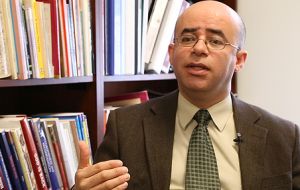This is a journey of the transformation of Catholicism and without faith you cannot have culture, a Boston College professor of Hispanic ministry said Wednesday, March 18.
“From the 1930s there was no official word for Latin Americans. The unofficial word used around the United States was ‘The Spanish Speaking.’” People became offended because some have been in the country for a few years.” Dr. Hosffman Ospino is an assistant professor of Hispanic ministry and religious education at Boston College, said during the third presentation of the Lenten Lecture.
Ospino was born in Colombia and had received a degree in philosophy. He is actively involved in the Latino ministry in Boston with his wife. He spoke to a boardroom of people about the understanding of the transformation of American Catholicism and also talked about Hispanic Catholicism.
“Most of my life I have been involved in some form of service in the Church, whether as an altar server when I was a child, or a catechist in my youth, or supporting teachers teaching theology and religion in elementary and secondary schools,” Ospino said. “In the United States I first became involved in the life of the Church by overseeing Hispanic ministry in a parish.”
The lecture was the third in the series presented by the Wolfington Center on March 18 in the Grace Hall boardroom.
His presentation started off with him getting to know the audience. There were students and faculty of different majors and areas of study within the audience. Each person was asked to talk about their major and generally introduce themselves.
“I thought he made the presentation pretty personal and I felt as though I can listen better and pay attention,” Brian Quirk, undecided sophomore, said. “And asking question didn’t feel awkward because of how friendly he was.”
Ospino talked about “Gaudium et spes,” which had been a theme throughout the Lenten lecture series and had been discussed throughout other presentations. He broke down how the document of “Gaudium et spes” was a “new vision of becoming a church”.
“This document was very debated but it invited us to a new way of becoming a church,” Ospino said.
Described from the past, Hispanic people did not have their own identity. Many people made generalizations from where they came from and made a name for the people who were actually Hispanic.
“If you lived in California or Texas you were considered Mexican. If you were from Florida, you were Cuban. And if you were from Philadelphia or Boston you were Puerto Rican,” Ospino said.
People of different ethnic groups that practiced the general Catholic faith eventually started to make their own versions of the church. This individualized the church in many ways and let people be their own label.
“The first Catholics in the United states were Hispanic,” Ospino said. The first parish of the Catholic church was Saint Augustine. Ospino creates the image of the church and how people started coming to the United States and basically started making a name for what they believe in.
The presentation was broken down into four sections about what helped frame the Hispanic reality in the United States.
“Faith and culture are two things that are intimately interrelated. We cannot have faith without culture and vise versa,” Ospino said.
The audience of teachers and students from around the area were amazed at the information presented at the lecture. During the presentation, the ideas were broken down so that everyone in the audience, no matter where they came from could understand.
Ospino talked about his time while he was in Colombia and when he moved to the USA, talked about how it was different from where he was from. Being in a completely different place, the United States, was to surround his children in a better society.



